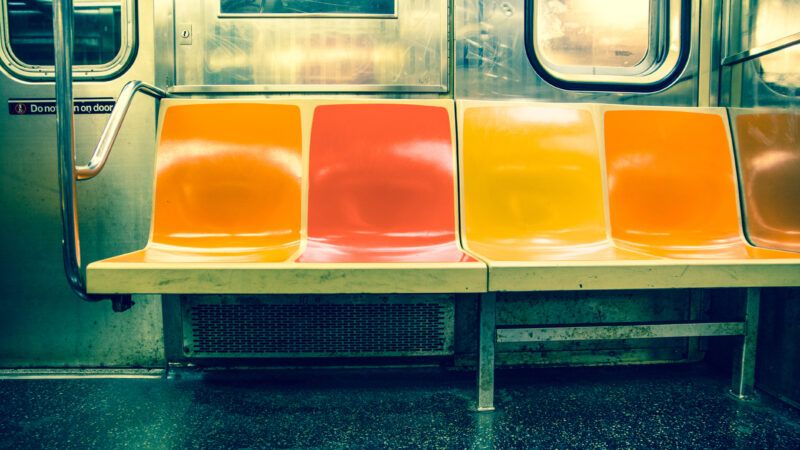New York Lawmakers Want To Use a 'Netflix Tax' To Pay for the Subway
From delivery fees to streaming taxes, New York can’t stomach having MTA users actually pay for the system themselves.

After New York City's Metropolitan Transportation Authority (MTA) approved a budget authorizing a 5.5 percent fare increase to address chronic budget shortfalls, the state assembly flew into action coming up with ways to avoid that. New York's latest tax scheme would attempt to pay for the MTA by hiking taxes on everyone from streaming services like Netflix to small delivery businesses to digital workers—basically, on everyone except the actual riders of public transportation.
Under its 2023 budget, the MTA is set to run a $600 million deficit, even after using nearly $1.8 billion in federal pandemic-related aid. Things will get even worse once that federal aid runs out—in 2025, the MTA is set to run a $3 billion deficit.
In place of fare increases, Gov. Kathy Hochul has now proposed an increase on the top payroll tax rate paid by employers: from 0.34 percent to 0.5 percent in New York City and surrounding counties served by MTA trains and buses. State legislators have countered with a hodgepodge of proposals, including a 2 percent increase on the top statewide corporate tax rate, applying state and local sales taxes to streaming services, and a new $0.25 "delivery fee" on delivery transactions within New York (with some exceptions).
While in general taxes are difficult to directly connect to the government services a taxpayer receives, user fees are not—the fee paid is directly related to the service received. With the ridership landscape fundamentally changing, that model is becoming increasingly untenable as the MTA refuses to adapt.
Transit ridership in New York City, like in other cities across the country, took an enormous hit during the pandemic, with ridership rates dropping below 40 percent of pre-pandemic levels. While ridership rates have somewhat bounced back post-COVID, it's unlikely that they'll return to pre-pandemic levels anytime soon. MTA ridership levels for February 2023 across buses and subways was about 65 percent of those of February 2019.
Rates of remote work may have peaked during the pandemic, but most Americans returning to the office aren't doing so on a daily basis, preferring instead to settle on a hybrid arrangement of working from the office some days and from home on others. To the New York City government, those days residents spend working from home are days residents are not swiping their MTA cards.
But most government agencies don't believe that a shrinking mandate means less funds are required, and they try to fight the tide. The proposed solution by New York legislators to shift the burdens onto the perceived "winners" of the increasingly digitized economy has unfortunately been the preferred response.
Corporate income tax increases are nothing new, but "streaming taxes" are. While other states and localities have looked to target digital and streaming services for special taxes, New York's proposal would actually just be subjecting Netflix to the normal statewide sales tax. That's at least better than, say, Chicago, which subjects streaming services to its 9 percent "amusements" tax instead of its 1.5 percent sales tax. It's certainly better than East St. Louis, Illinois, which attempted to penalize streaming companies for "trespassing" on city property to deliver streaming services to its residents.
But possibly even worse than a streaming tax is the seemingly innocuous $0.25 "delivery fee." A similar law was passed in Colorado in 2021, requiring sellers to charge a $0.27 fee on all deliveries within the state. While not an enormous amount of money, this "fee" has given smaller retailers disproportionate headaches over the difficulty of tacking it on to invoices and including it in their sales tax compliance systems. For small businesses already struggling with the fallout of new state laws requiring remote sales tax collection, this would be yet another kick in the gut.
Taken together, these tax proposals represent an effort to shift the burden of paying for an overspending MTA off of the New Yorkers who use it and onto other taxpayers, including those who are out-of-state. That's a strategy New York has already aggressively pursued through its "convenience of the employer" rule.
Despite how the phrase sounds, "convenience of the employer" rules are anything but convenient. They effectively require employees who work for New York companies to continue paying New York taxes even if they work remotely out of state and never set foot in New York throughout the year. Not only does this violate basic principles of tax fairness, but it also subjects taxpayers to the risk of double taxation when they get stuck in a tug of war between the tax departments of their state of residence and New York.
These aggressive policies of exporting tax burdens are a major reason that New York is ranked 47 out of 50 on a recent report by the National Taxpayers Union Foundation that ranked states on their tax policies toward remote workers. They also represent New York's determination to refuse to acknowledge or embrace the change brought about by the pandemic, choosing instead to try to creatively shift tax burdens elsewhere.
But whether New York likes it or not, things have changed. Taxpayers can choose to live further from their jobs and don't have to sit on packed trains every day if they don't want to. Unfortunately, it seems that just about the only people who won't have to pay for the MTA refusing to acknowledge that fact are the people who still use it.
Show Comments (40)